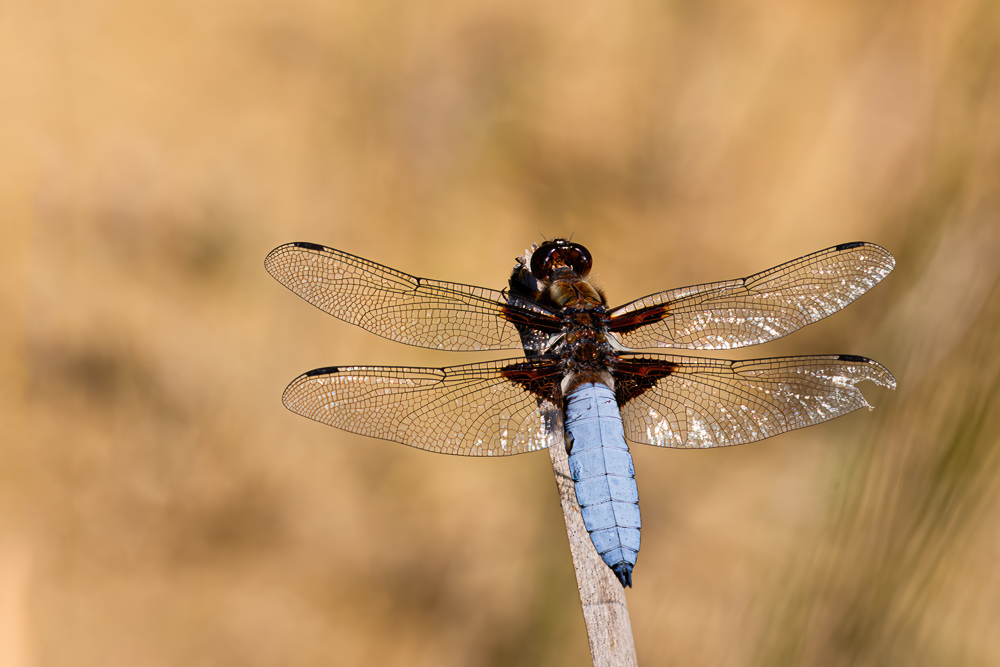Dragonflies are known by some as the ‘gems of the air’. Many of them look beautiful - the damselflies, emerald dragonflies, emperors and so on. They are great flying artists that can not only fly very fast (up to 50 km/h), but can also remain stationary in the air or even turn on the spot.
Their appearance, their flying skills and the fine structure of their wings make them a fascinating subject for photographs.
However, two facts should be mentioned first:
- Dragonflies are harmless. They cannot sting and any bite that occurs out of fear is not painful.
- Dragonflies are protected. They may not be caught, injured or even killed.
Like other wild animals, dragonflies have a flight distance. They react to movement. Therefore, fast movements should be avoided, even with the camera. If you move slowly towards them, it is possible to get within 1 metre or even closer.
It is relatively easy to photograph dragonflies with today's digital cameras. Even though SLR cameras or mirrorless system cameras are often used, bridge cameras or even simpler compact cameras can also take good pictures.
If you want to photograph dragonflies, the first thing to think about is a macro lens. There is one thing to bear in mind when choosing a lens: Dragonflies - like all other animals - have a flight distance, which means that they flee if we get too close to them. How great this distance is depends on several factors and can only be tested.
A macro lens should therefore have a longer focal length. Lenses from 100mm are a good choice. The speed of the autofocus is important if flying insects are to be photographed, as some of them travel quite fast.
But there is an alternative to macro lenses: telephoto lenses. 300mm focal length, 600mm or even more (with a teleconverter). A longer focal length increases the magnification, but also reduces the depth of field.
Nevertheless, a longer focal length has two advantages:
- The distance to the dragonfly (or to the animal in general) is greater and reduces the flight reflex.
- Often enough, the dragonfly cannot be reached because it is located in an area that is not accessible.
If longer focal lengths are used, it can be interesting to work with a tripod to prevent vibrations. However, today's cameras have good image stabilisation, so that even with focal lengths of 400mm or longer it is still possible to work without a tripod. If necessary, it is often possible to rest the camera on a tripod or clamp it against a tree.
Some dragonflies are ‘perching hunters’, which means that they hunt their prey from a fixed spot and return again and again. These include, for example, the Banded Demoiselle, the Four-spotted Chaser and the Black-tailed skimmer These can often be seen sitting on branches or on the ground. I usually work with a telephoto lens for these shots to keep my distance from the animals and not scare them away. Focal lengths starting from 100mm are interesting here, I also use 600m or 840m depending on the distance... Here you have to take into account that a longer focal length leads to a smaller depth of field.
For autofocus, I use one sensor point or a maximum block of nine points so that no interfering elements confuse the autofocus.
Exposure time and aperture depend on the focal length. With a focal length of 600mm, I set the exposure time to 1/800 s, usually at f/11. The ISO value is set by the camera, which works relatively well with the Canon EOS 5D III.
I usually work in series mode, which means that I take several shots in quick succession. This makes it possible to take pictures even in slightly windier conditions or when the dragonfly takes off for a flight.
I have a special howto for capturing dragonflies in flight dragonflies in flight
